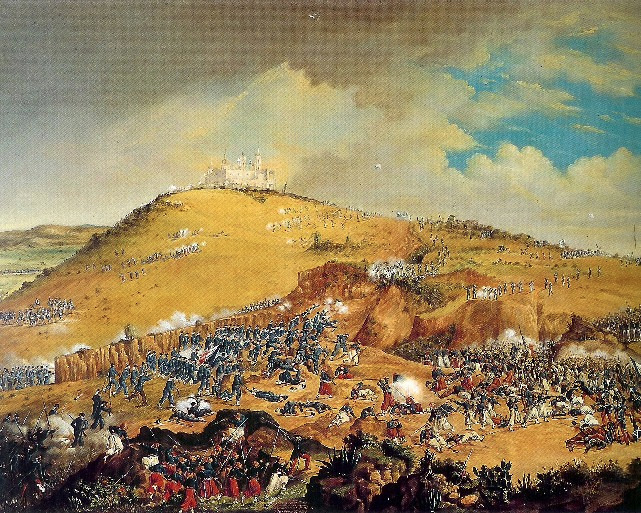
The theme for the May 4, 2014 edition of Johnny D’s Jazz Journal is “Sueños: The Cinco de Mayo Show”. “Sueños” is Spanish for “dreams,” and in this case it refers to 19th-century Mexico’s dreams of freedom following centuries of domination by Spain and France; coincidentally, the word sueños also kept popping up in the titles of the songs I was auditioning for this show, so it became a recurring motive.
In my on-air introduction, I mention that many people mistakenly think of Cinco de Mayo as “Mexican Independence Day”. I couldn’t take the time during the show to provide a detailed explanation of how May 5 does and does not factor into that story, so I thought I’d write about it here. Maybe, like me, you’re a history buff as well as a jazz buff.
Under the leadership of Conquistador Hernando Cortes, invading Spanish forces conquered the Aztecs in 1521, beginning 300 years of Spanish rule over what became known as Mexico. On September 16, 1810, a Catholic priest, Father Hidalgo, inspired his countrymen to revolt, and after 11 years of conflict, Mexico won its independence from Spain in 1821. It’s September 16, then, not May 5, that’s Mexico’s “Fourth of July”. Cinco de Mayo acknowledges something that happened 41 years after Mexico won its independence, and presumably few people on either side of the border are aware that it involved Emperor Napoleon III and, indirectly, our own Civil War.
Four decades after becoming a sovereign state, Mexico’s new government still struggled to control the far-flung country it had wrested away from Spain. Meanwhile, economic woes were exacerbating growing territorial tensions with the rapidly westward-expanding US, resulting in the two-year Mexican- American War (1846-48). The US won that conflict and annexed parts of Mexico, which was left bankrupt by the war, unable to repay its existing debts to Spain, England, and France.
When our own Civil War began in 1861, the leadership of the Confederacy knew that its prospects for success would be greatly enhanced by assistance from a foreign government. At the time, the greatest military power on earth was France, and Napoleon III and the heads of several major French industries mulled the economic and territorial potential in an alliance with the Confederacy.
In 1862, Spain, England, and France, rebuffed by Mexican President Benito Juarez in their attempts to collect the money owed them by Mexico, decided to force the issue. They sent armed forces to Veracruz, a major port on the Gulf of Mexico, with a plan to intercept Mexican customs payments. President Juarez soon negotiated a compromise with Great Britain and Spain, and their armies returned home. France, however, had other ideas.
Napoleon III was wary of America’s expansion, industrialization, and growing power, and like a Mafia boss he sought to conquer a weakened Mexico rather than write-off its debt. He also relished the idea of controlling the country that bordered the Confederate States; if he could defeat Mexico, he could join the American South in its war with the Union and deliver a mortal blow to America’s expansion. He sent his troops from Veracruz with orders to take Mexico City.
Early on May 5, 1862, French General Laurencez and 8,000 troops (including 2,000 French loyalists), encountered resistance near Puebla, Mexico, just 100 miles east of Mexico City. Defending Puebla were Texas-born Mexican General Ignacio Zaragoza and a force of 4,000 troops, many of them farmers armed with antiquated rifles and machetes. Zaragoza was no military tactician, but he was experienced in guerrilla warfare, and this proved decisive in a battle that was waged on a muddy, uneven field criss-crossed with ditches and adobe ruins. The Mexican army won the day and chased the French troops to the coast. It was France’s first military defeat since the Battle of Waterloo almost 50 years earlier. Although France eventually conquered Mexico, the country never surrendered its dreams of independence, which it finally regained in 1867.
A year after the Battle of Puebla, some Californians decided to toast Mexico’s decisive victory with a fiesta. Cinco de Mayo remains a mostly Californian event to this day.

